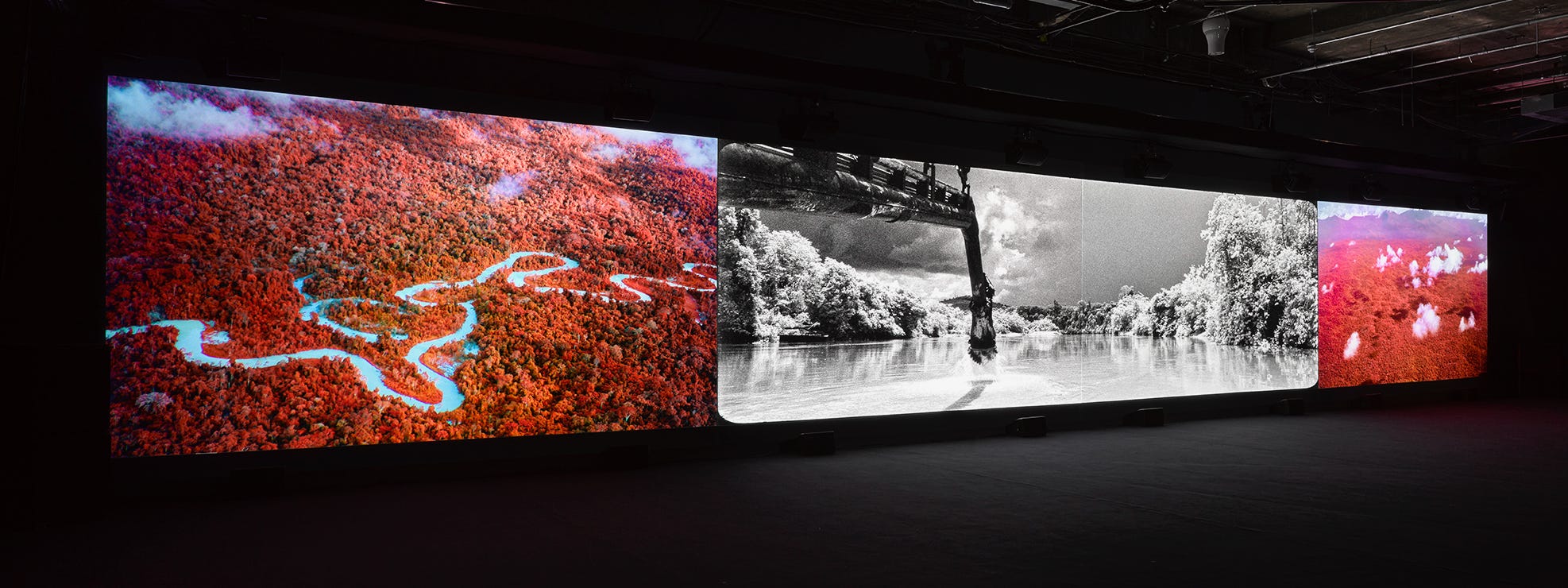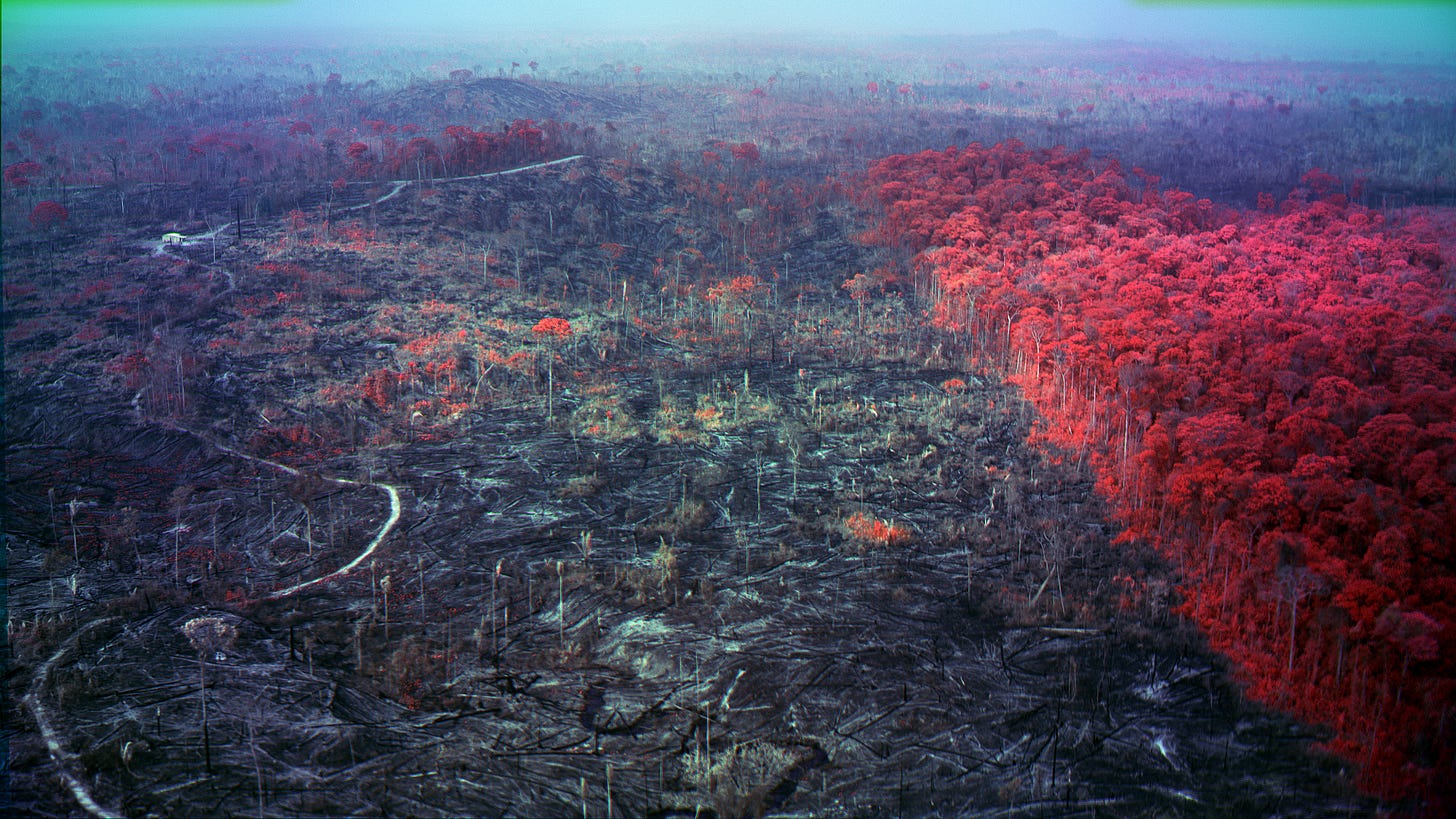Making destruction in the Amazon visible
🌐 A distinctive take on the story, through the lens of Richard Mosse.

🌐 WorldWise View | global perspectives on health, development, planet
Exposures that stop you on your tracks.
The fate of the Amazon rainforest was one reason why the world was watching Brazil’s recent elections very closely: scientists keep warning that after years of destructive activity, it’s coming ever closer to an ecological point of no return.
We read the statistics, but most of us need help to really grasp what that means.
In September, while on a brief reporting trip to the state of Pará, I could pick up just pieces of the puzzle: fire-orange blotches of burning land from a night flight; dam infrastructure blocking transport on a major tributary; a mix of resignation and determination in the eyes of Indigenous women lamenting the loss of traditional life with the river.
The scientists and local experts I travelled with helped to connect the dots. Fellow journalists in the group captured them with their stories.
Still—to understand isn’t just about piecing together information. And much of what goes on simply isn’t easy to see with the naked eye.
I didn’t come to this realisation fully until an encounter with a piece of art. Shortly after returning to London I accepted an invitation from 180 The Strand to a press preview of Broken Spectre, a work by photographer Richard Mosse, who spent the past five years documenting environmental crimes across remote parts of the Brazilian Amazon.
Primed by my visit to the region, the exhibition touched a nerve.
In an opinion piece published last week in Undark magazine, I discuss the work from one particular angle: how Mosse uses technological tools in a way that transcends their original purpose to create a distinctive take on this globally significant story.
This is the bottom line of that argument:
The work is powerful not just visually but in the substance of what it documents, and in how Mosse’s choice of technology reaches across vastly different scales—from aerial views to close-ups of the biome—to expose what’s unfolding deep in the rainforest.
But it’s worth also looking at what else is behind the work’s storytelling prowess, which isn’t down to technology alone.
Emotional impact
You may well know what deforestation means. But sit through the immersive film display in Broken Spectre, and you’ll be shaken by the thud of a single tree falling. You’ll then meet the unflinching gaze of Adneia, a woman from the Yanomami tribe pleading for protection in an impassioned monologue.
Broken Spectre’s depictions and sounds of what’s unfolding in the forest are unsettling as much as they are revealing—and that emotional impact is one of the ways in which Mosse captures our attention, draws us closer, and gets us to open up to the message.
Visual aesthetics
He also does this through aesthetics. Much of Broken Spectre relies on remotely sensed imagery, which is integral to scientific monitoring of the destruction Mosse set out to document. Satellite imagery is typically combined with Geographic Information Systems to produce maps that track how landscapes change over time, and how those changes relate to human activity. It’s now popular in multimedia journalism too. But the artist takes it further by capitalising on its visual potential, notably through a vibrant colour palette.
Substance and meaning
It’s an example of how scientific technology can be adapted to tell a compelling story with strong visuals. It’s also an example of how a simple focus on visual appeal doesn’t go far enough.
We’ve seen satellite imagery presented as abstract art, in the National Geographic for example, or to communicate how the Earth is changing. But displays of this type lean more on aesthetic than substantive qualities. Broken Spectre’s eye-catching visuals are also an exposing of destructive activity—they have a strong connection with meaning and capture distinct features linked to the story.
‘Groundtruthing’ and relationships
There’s also ‘groundtruthing’—i.e. validating what’s seen from the sky with direct observation on the ground—and a nod to the journalistic pursuit of balance (which doesn’t mean both sides are given equal weight).
Mosse spent time in the region, forging relationships and getting close to people on both sides of the story. The portraits of gold miners hoping for a better life, for example, sit alongside those of Indigenous guardians of the forest. And his choice of medium, the multispectral technology vital for scientific monitoring of forest loss, is also popular with the agents of destruction: cattle ranchers, famers who monitor soy, companies prospecting minerals.
Layers and scales
Broken Spectre helps us to see layers of life in the rainforest with imagery captured and presented at different scales. There’s the biome in close-up detail, presented through fluorescent microscopic imagery, a technique used in biomedical science. We then move from the micro to the macro and closer to the scenes of the crime. Through a film shown on a 20-metre-wide screen—in part produced with a multispectral camera custom-made for moving image—we see fires engulf a solitary house on stilts, loggers power through massive tree trunks, workers delicately panning for gold, cattle ranchers reminiscent of cowboys in the American West.
That’s the kind of activity driving the Amazon ever closer to a ‘tipping point’, where it’s expected to gradually turn into savannah, releasing more carbon than it absorbs—a flip that’s happened already in parts of the rainforest. That’s bad news not just for life in the region. Global climate targets count the rainforest as a vast carbon sink: remove that from the equation, and the chances of meeting those targets fades further into the distance.
Political leadership is important. So is public awareness. That’s why we need imaginative ways to tell the story.
📸 More about Broken Spectre in a new book and multiple exhibitions worldwide
🌐 WorldWise highlights | news, analysis and media opportunities
Story Threads
Each post in the weekly Briefings ($) edition of the newsletter brings you a curated collection of the week’s global stories—three highlights from recent posts:
Top story—A number of post-mortems on COP27 examine the small steps of progress taken at this year’s UN climate summit but arrive at the same bottom line: that despite the historic step of setting up a loss and damage fund—vague and empty as it is right now—there’s no movement on something that changes the world’s course on greenhouse gas emissions.
Trend to watch—The soaring cost of living has led to a drop in global wages this year for the first time on record, according to the UN’s labour agency. This threatens to worsen inequality and drive social unrest. Food prices are expected to stay high as war and adverse weather patterns continue. Governments are also cash-strapped in much of the developing world, so much so that they have to resort to service cuts to pay debts.
Under the radar—Measles is "an imminent threat in every region of the world", the WHO and US health agency have said in a joint report. It’s one of the most contagious human viruses, and millions of children are now more susceptible to it as vaccination rates have dropped since the start of the pandemic. Polio, another vaccine-preventable disease, is also re-emerging.
Media Insider
Each post in the biweekly Media ($) edition kicks off with an idea to consider about working in communication or as a freelancer—two highlights from recent posts:
Working to tipping points—The concept of a tipping point has its origins in sociology, but it wasn’t until Malcolm Gladwell published his book of that title in 2020 that it became mainstream. There’s good reason for that popularity: it captures and brings to light a part of our experience that bubbles under the surface. But it’s also a hopeful concept. A way to keep the faith when your efforts seem to only produce baby-steps forward.
Start from the love—I had a reality check alongside the practical tips for those who attended my workshop on how to publish a newsletter at the Science Journalism Forum back in October. There’s a lot of hype about newsletter publishing being an easy way to make money or get noticed. But things don’t always turn out that way. So what I say is: start from the love—do what you *really* want to be doing. You’re much more likely to make it through and make it last if you start with something you love and believe in.
🎁 Treat a colleague—and support WorldWise—by giving a Pro subscription.
🌐 WorldWise sounds | from a global soundtrack
✔️ Independent, thanks to your support
🤍 Liked this email?
Support WorldWise with a one-time Ko-Fi donation—or simply share the post
📩 Connect
Want to suggest someone to interview or a potential partnership? Get in touch




